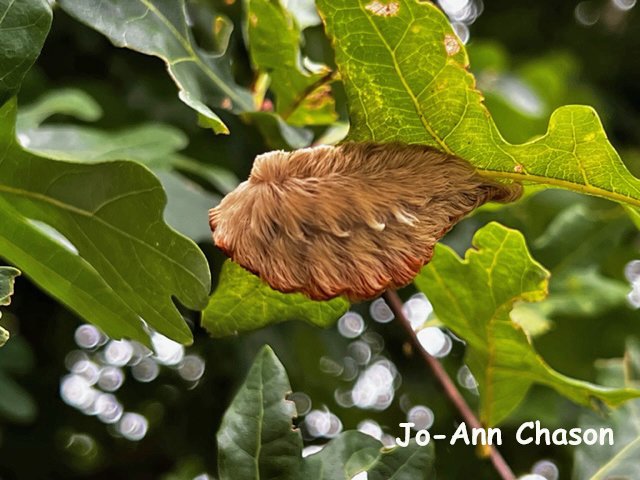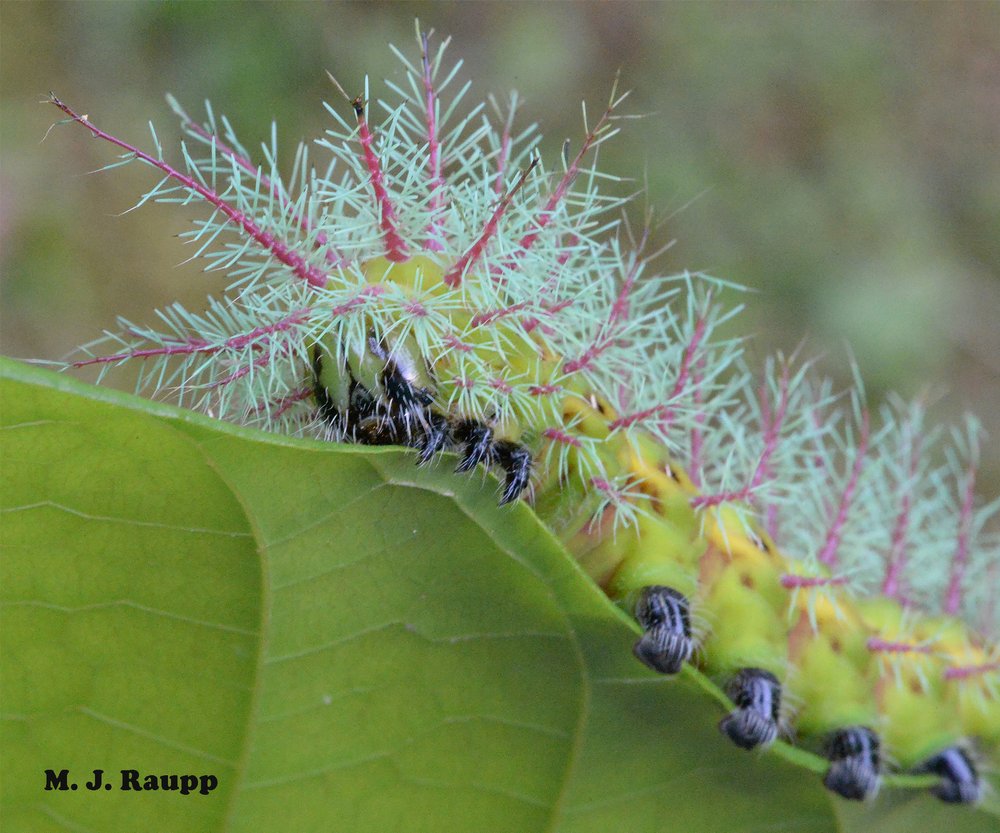Look but do not touch: puss caterpillar, Megalopyge opercularis; White flannel moth, Norape ovina; Io moth, Automeris io; buck moth Hemileuca spp.; and hag moth, Phobetron pithecium

Look at – but do not touch! – the furry puss caterpillar. Image credit: Jo-Ann Chason
A few weeks ago, we visited stinging saddleback caterpillars as they bedeviled my attempts to weed a flower bed. Recently, an insect aficionado sent me a beautiful picture of a caterpillar resembling Cousin Itt, the gibberish speaking who-knows-what from the classic 1960’s television series, The Addams Family. Like Cousin Itt, the puss caterpillar, a.k.a. the southern flannel moth, is cloaked with strands of long blondish hair with no other features clearly visible (unlike Cousin Itt, the puss caterpillar does not wear a bowler and dark sunglasses). According to some sources the moniker “puss” stems from the caterpillar’s semblance to a rather tiny and very hairy cat. Ah, but this little puss packs a punch in the form of stinging spines concealed just beneath the cloak of attractive hairs. These barbed spines are described as urticating, from the Latin meaning “nettle.” Urticating spines can break off, embed in skin, and deliver a potent dose of venom. Venom from puss caterpillars and others in this episode can produce instant and building pain that has been described as burning, stinging, and “white hot”. Localized swelling, redness, and blisters may form. In some cases, systemic allergic reactions occur and medical attention should be quickly sought. Contact with mucous membranes in eyes and nasal passages are particularly serious and should be dealt with immediately. Despite these dire reactions, some say they have handled these stingers without sustaining stings or irritation, but why take a chance? Puss caterpillars are found here in the DMV and south to Florida and Texas. Oak is one of their common hosts but apple, birch, hickory, pecan, persimmon, and rose are also on the menu.

Tropical Io moth caterpillars have incredibly long urticating spines.
On leaves on a redbud tree in my front yard, I bumped into another stinger, caterpillars of white flannel moths, Norape ovina, which also find black locust, hickory, and other woody plants delectable. White flannel moths range from the DMV to the Deep South where two generations occur annually. In previous episodes of Bug of the Week, we met another clan of moths with urticating hairs, a large and beautiful Io moth caterpillar (Atomeris metzil) from Costa Rica and our home- grown Io moth (Automeris io) here in the DMV. These remarkably beautiful caterpillars feast on a wide range of woody and herbaceous plants including trees, shrubs, and grasses. The Io moth found in the DMV ranges from Canada, where but a single generation happens each year, to the Gulf of Mexico, where three or more generations occur.
Our next stinger in this quintet of pain and itch is the buck moth, one of many spiny rascals in the genus Hemileuca. Buck moth caterpillars favor oaks as a food source and they can be found from Maine to states along the Gulf of Mexico. Caterpillar guru David Wagner reported their stings to cause small hemorrhages lasting several days. The beauty in this episode was seem marching along a fence pole overlooking Great Falls in Potomac, Maryland. One late summer afternoon at the marvelous Catoctin Creek Nature Center, I was treated to a marvelous performance by a waltzing hag moth caterpillar, a.k.a. monkey slug, as it toted its strange furry adornments along a branch of a redbud tree. Many other common woody plants are also eaten by this caterpillar, which can be found from southern Canada to the Gulf Coast. These caterpillars are among the most interesting and attractive of all to be found in the summer and autumn, but please don’t handle them yourself or let youngsters handle them. Let’s avoid a nasty surprise that could develop into an unwanted fear of these remarkable creatures.
This quintet of pretty caterpillars packs a wallop delivered by stinging, urticating spines. The puss caterpillar looks like Cousin Itt from the Addams Family to me. Next up are attractive caterpillars that turn into white flannel moths, but their sting does not feel anything like flannel. Io moth caterpillars are relatively common throughout much of eastern North America. Just look at their long spines. The buck moth caterpillar is in a hurry, perhaps to find oak leaves, a favored food. They too can give a nasty sting. And my favorite of the five is the very strange and adorable hag moth caterpillar. What are those wavy arms about?
Acknowledgements
We thank Jo-Ann Chason for providing the nice image of a puss caterpillar that served as the inspiration for this episode. Two excellent references, “Stinging and Venomous Caterpillars of the Southeast” by Rebecca Perry and Adam Dale, and “Caterpillars of Eastern North America” by David Wagner provided details on these interesting stinging caterpillars.
This post appeared first on Bug of the Week